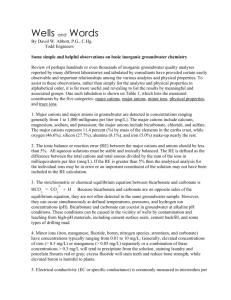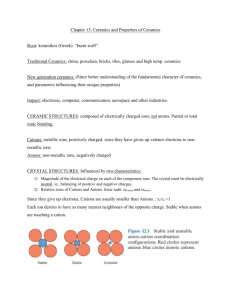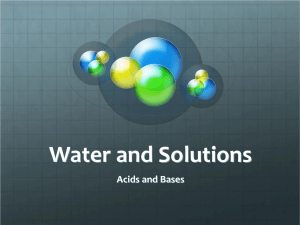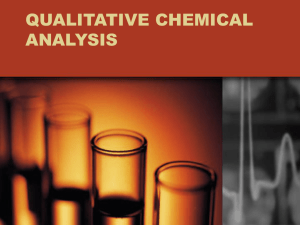Groundwater Chemistry
advertisement
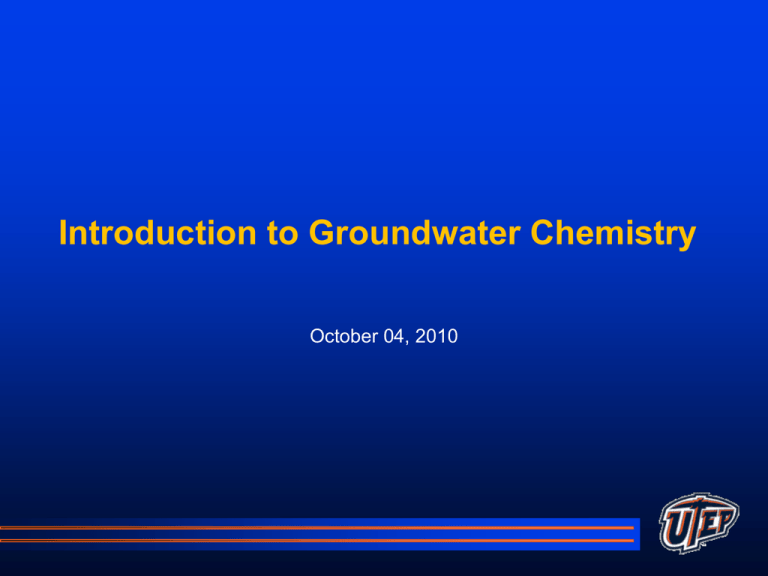
Introduction to Groundwater Chemistry October 04, 2010 Units of Measurements 1. Common units are (1 mg/L = 1 ppm = 1000 ppb). ppm = 1 part in 1,000,00 (106) parts by mass or volume 2. Molar concentration (molarity) = moles of solute per liter of solution. molarity = moles of solute/ liter of solution 3. Molality = moles of solute per kilogram of solvent (not solution). molality (M) = moles solute/kg of solvent molality = (mg/l) *0.001/formula weight in grams 4. Equivalent weight of a substance is the amount of that substance which supplies or consumes one mol of reactive species. An element's equivalent weight is its atomic weight divided by its valence. meq/l = (mg/l)/valence of ion Units of Measurements In order to convert the mass concentration to an equivalent concentration the following mathematical relationship is used: (mass concentration) * (ionic charge) / (molecular weight) = (equivalent concentration) For example, a water with a calcium concentration of 120 mg/L would have the following calcium equivalent concentration: (120 mg/L) * (2 meq/mmol) / (40 mg/mmol) = (5 meq/L) Types of chemical reactions in water 1. Reversible reaction can reach equilibrium with their hydrochemical environment. The simplest aqueous reaction is the dissociation of an inorganic salt. If the salt is present in excess, it will tend to form a saturated solution: NaCl == Na+ + Cl- If the solution is undersaturated more salt will dissolve. If it is supersaturated, salt will crystallize. 2. Irreversible reaction: one way reaction, A+B ---- C+D Law of mass action Law of mass action: the reaction will strive to reach equilibrium. cC + dD == xX + yY Equilibrium constant (K) = [X]x [Y]y / [C]c [D]d Major ion chemistry More than 90% of the dissolved solids in groundwater can be attributed to: Na, Ca, K, Mg, SO4, Cl, HCO3, and CO3 These ions are usually present at concentration greater than 1mg/l. Silica, SiO2, a nonionic species, is also present at concentrations greater than 1mg/l. Direct analysis can be done for the first six ions. Bicarbonate and carbonate concentrations are found by titration with acid to an endpoint with a pH of about 4.4. pH, Temperature, and specific electrical conductance are usually made at the time the sample is collected. Other naturally occurring ions that may be present in amount of 0.1mg/l to 10 mg/l include iron, fluoride, strontium, and boron. Major ion chemistry Iron and nitrate are typically included in water-chemistry studies, with fluoride, strontium, and boron being less commonly reported. Total dissolved solids (TDS) can be determined by evaporating a known volume of the sample and weighing the residue. TDS can be estimated by summing the concentrations of the individual ions. Ion Exchange Sites Location selection Under certain conditions, the ions attracted to a solid surface may be exchanged for other ions in aqueous solution. The ion-exchange process can be conceptualized as the preferential absorption of selective ions with contaminant loss of other ions. Ion-exchange sites are found primarily on clays and soil organic materials, although all soils and sediments have some ion-exchange capacity. A general ordering of cation exchangeability for common ions in groundwater is: Na > K > Mg > Ca Ex. Sodium adsorption ratio (SAR): SAR = Na / [ (Ca+Mg)/2 ]0.5 If SAR between 2 and 10, little danger from sodium If SAR between 7 and 18, medium hazards If SAR between 11 and 26, high hazards Presentation of results of chemical analysis A cation-anion balance is usually performed as a check on the chemical analysis. This is accomplished by converting all the ionic concentrations to units of equivalents per liter. The anions and cations are summed separately, and the results are compared. Charge Balance For any solution, the total charge of positively charged ions will equal the total charge of negatively charged ions. Net charge for any solution must = 0 Charge Balance Error (CBE) m z m CBE m z m c c a za c c a za Tells you how far off the analyses are (greater than 5% is not good, greater than 10% is terrible…) Stiff Diagram Characterizes Water Chemistry Analyses in meq/l are plotted on four parallel horizontal lines. Concentrations of up to four cations and anions can be plotted, one each to the left or right of the center zero axis. Resulting points are connected to give an irregular polygon pattern. Stiff patterns can be a relatively distinctive method of showing water-composition similarities and differences. Schoeller Diagram Line Plot That Characterizes Water Semi-logarithmic diagram that represents major ion analyses in meq/l. Demonstrates different hydrogeochemical water types on the same diagram. Number of analyses plotted at one time is limited. Actual parameter concentrations are displayed. Schoeller Diagram Concentration (meq/l) logarithmic scale 1000.0000 Groundwater 100.0000 10.0000 Surface Runoff 1.0000 Precipitation 0.1000 0.0100 0.0010 Ca Mg K Si Na Cl F Major anions and cations SO4 HCO3 Average concentration of major anions and cations of groundwater, surface-runoff, and rainfall Piper Diagram Shows Groupings of Water Types Major ions are plotted as cation and anion percentages in meq/l in two base triangles. Total ions are set to equal 100%. Data points in the two triangles are projected to central diamond. Allows comparison of a large number of samples. Shows clustering of samples and water type. ASARCO Data Station Name EP-114 EP-116 EP-119 EP-12 EP-122 EP-13 EP-131 EP-132 EP-133 EP-135 EP-49 EP-51 EP-58 EP-62 EP-68 EP-75 EP-77 EP-81 EP-85 EP-85 SEP-1 SEP-1 SEP-10 SEP-11 SEP-12 SEP-13 SEP-2 SEP-3 SEP-4 SEP-6 SEP-7 Bicarbonate Alkalinity As Calcium (Ca) CACO3 TOTAL 400 603 356 284 384 157 876 215 304 182 348 423 520 100 294 221 416 234 500 609 502 556 206 933 860 533 362 165 460 292 464 467 503 65.3 146 89.4 316 121 310 121 260 126 250 125 320 194 340 166 306 143 322 142 338 163 218 105 290 141 222 108 216 106 Carbonate Alkalinity As CACO3 UNKNOWN Chloride (Cl) Magnesium (Mg) Potassium (K) <1 214 222 164 <1 390 55.5 45.5 <1 400 64 52.5 <1 203 67.8 12.1 <1 197 78.9 49.9 <1 946 67.2 87.4 <1 212 36.2 14.2 <1 413 44.6 45.3 <1 324 66 49.4 <1 991 176 16.4 <1 288 130 242 <1 4830 772 55 <1 829 225 226 <1 415 68 59.7 <1 575 119 14.6 <1 299 289 662 <1 120 18.3 16.2 <1 33.8 34.6 10.3 <1 156 52.4 49.7 <1 155 52.3 45.9 <1 378 33.7 14.6 <1 361 33.8 14.6 <1 994 101 20.4 <1 659 72.8 30.6 <1 663 61.7 27.6 <1 651 61.9 24.9 <1 677 71.8 29.2 <1 369 25.5 13 <1 638 61.4 22.6 <1 370 26.3 13.2 <1 362 24.9 13.1 Sodium (Na) 471 766 699 891 560 2560 650 752 1170 1340 1400 1910 1890 829 798 3020 604 105 507 514 468 467 1440 874 880 876 863 432 845 446 435 Sulfate (SO4) 3160 2000 1310 1250 1340 4610 1210 1540 1990 3060 4320 2270 4480 1290 1740 9240 906 382 1000 964 627 568 1770 1360 1280 1360 1490 500 1250 487 504

